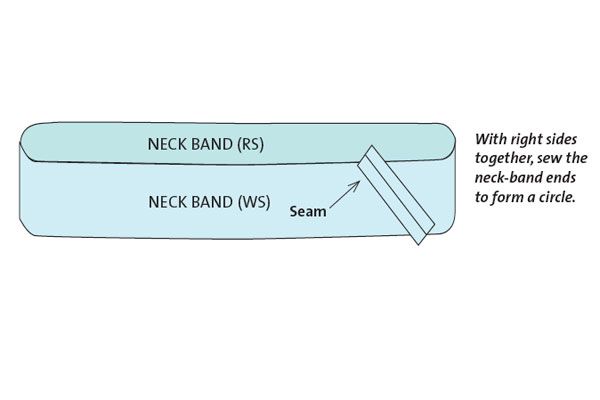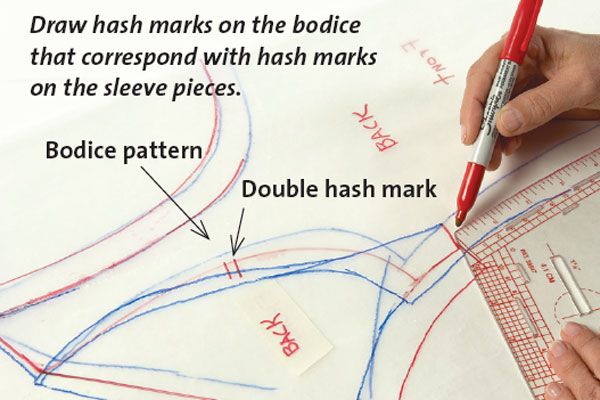
When you sew your own T-shirts, you can refine the fit, alter the necklines, choose the perfect knit fabrics, and otherwise shape them to flatter your figure. Once you learn how to make a pattern from your favorite store-bought T-shirt, you can reproduce it in every color for every season and add special details along the way.
What you’ll need
Foamcore (foam board)
Pattern paper or wax paper
Needle-point tracing wheel
Ruler
French curve
Pencil
Pins
Clear elastic
Thread
Fusible interfacing
T-shirt knit fabric
Twin needle (optional)
Trace your tee
Prepare your favorite T-shirt by gently pressing it flat. Be careful not to stretch or distort it. Press it using an up-and-down motion; don’t slide the iron over the shirt. Then fold the front neckline in half from shoulder seam to shoulder seam, and insert a pin vertically at the center-front neckline fold. Repeat on the back to mark the center-back neckline and on the center-front hemline.
1. Lay out the pattern paper and the T-shirt. Lay the pattern or wax paper over the foamcore. Smooth the T-shirt over the paper so the shoulder seams and side seams are exactly on the T-shirt edge and the vertical pins at the back and front necklines and hemline are aligned. Mark the paper at the pin locations. Hand-press out all bumps and wrinkles, and align the front armhole with the back armhole on both sides. If one layer is wider and won’t lie flat, it’s OK if the armhole seams don’t align. Carefully pin the T-shirt to the foamcore.

2. Trace around the tee. Trace around the sleeves, shoulders, side seams, hems, and the highest part of the neckline with a pen or pencil. If the seams align, run a needle-point tracing wheel over the armhole seam. If they don’t align, run the wheel over the the front and back armhole seamlines, tracing their shape. Run the wheel over the neck-band seam from shoulder to shoulder.

3. Refine the pattern. Remove the T-shirt, and draw a center line connecting all three pin marks at the center necklines and hemlines on the paper. This line designates the center front and center back. Then fold the pattern along that line, hold it up to a light, and compare the halves. Make the side seams and hemline identical shapes, and split any differences between them. Tidy up the armholes and the inside neckline seam with a French curve as a guide, so they are smooth curved lines. Cut the pattern in half along the center line. Label the right half “Front” and the left half “Back.” On a separate piece of pattern paper, trace a sleeve. Trace the sleeve front; then align the foldline with the sleeve back, and trace it. Add 1/2-inch seam allowances and a 1-inch hem allowance. On the front armhole seamline, draw a hash mark at the halfway point. On the back armhole, draw a double hash mark at the halfway point. Make corresponding marks on the bodice armholes.


4. Cut the pattern. Cut the right side of the pattern along the front armhole seamline and the left side along the back armhole seamline.
Test and prep the fabric
If you want the new pattern to fit like your old T-shirt, make sure the old and new fabrics have the same amount of cross-grain stretch.
1. Test the fabric stretch. Turn up the T-shirt hem by 6 inches. With your thumbs 6 inches apart, stretch the fold to its maximum width, and measure the length while you hold it stretched. Then turn up 6 inches of the new knit and stretch the fold in the same manner. If it stretches to the same length or more, the new tee will fit the same as the original.

2. Prepare the fabric. Preshrink and press the fabric before cutting, using the washing method you’ll use for the finished garment. Many knits have a subtle directional shading, so use a “with nap” layout whenever possible. Cut T-shirts on the lengthwise grain.
Sew seams and hems with ease
You don’t need a serger to make beautifully constructed knit garments; since knit fabrics don’t ravel, a raw or pinked edge works fine. (Insiders, find more advice on working with knits in “Expert tips for finishing knits.”)
1. Choose the needle and thread. A size 80/12 universal needle and good-quality, all-polyester thread work well for most lightweight knits. If you get skipped stitches on tissue knits, use a smaller (even a size 60/8) needle with a ballpoint. Twin needles make fine hems; try a 4-mm-wide 80/12 universal needle.

2. Pick a stitch. Use a standard straight stitch. For very stretchy knits, set the machine for the narrowest, “baby” zigzag stitch, which will read as a straight stitch.

3. Sew and stabilize the shoulder at the same time. When stitching the shoulder seam, lay the T-shirt back side up, place a strip of clear, unstretched elastic over the seamline, and stitch through it. Press the seam without touching the elastic, so it doesn’t melt.

4. Sew the hem. Before assembling your T-shirt, prepare the hems by pressing them into place. Next, apply a narrow cross-grain strip of soft, knit fusible interfacing, such as Sof-Knit from HTC, to the hem allowance’s wrong side, to reduce rippling (A). After assembling, sew the hem from the right side with a single or twin needle (B).

Finish the neckline
Before cutting the neckband, try on the shirt. Nothing more will be done to the cut edge of the fabric on the neck before the neckband is applied, so you can see whether you need to adjust the neckline so it fits closer to the body (this is simple to do with a neck band). Measure the width of the neck band on the original T-shirt. Then follow the steps below to reproduce it. (Watch a video with additional pro tips on applying a neckband to a knit top.)
1. Cut the neckband strip. Cut a cross-grain strip twice the desired finished width, plus two seam allowances. Trim it to the length needed. A 3:4 to 7:8 ratio between the length of the binding and neckline generally works well. Cut the ends at a 45-degree angle, as shown below.

2. Form the strip into a circle. With right sides together, stitch the strip’s short ends together.

3. Pin the band in place. With wrong sides together and raw edges aligned, fold the band in half lengthwise. Position the band’s seam off-center at the back, and pin-mark the band in quarters.

4. Sew on the band. With right sides together and pins and raw edges aligned, position the band over the neckline so the feed dogs can help ease in the longer garment layer. Stretching slightly, stitch the band to the neckline. Turn the folded edge up, and press. You can topstitch along the neckline seam to anchor the band’s seam allowances to the shirt, if you like, and then press.

Add embellishments
The embellishment shown was made from single-layer fabric hearts, gathered down the center, and stitched randomly on the T-shirt.

Written by Judith Neukam and excerpted from SewStylish Spring 2010, p. 67.
Photos: (model) Jack Deutsch; all others, Sloan Howard.























































I have to clawn a top and finding Judith Neukan's article, has taught me many details I didn't know, as I have never worked with knit fabrics. For me is going to be quite an experience, hope it works out fine. So grateful, many, many thanks.
I would not fold the t-shirt because the thickness at the centre (4 layers of fabric) can cause incorrect estimates
Thank you for these very clear instructions! I have saved a tee for years hoping to do this, but during that time I’ve gained some weight and need it to be a size or two larger. Do I simply make the side seams wider? I don’t think the sleeves or neck will need enlarging.
Hi, user-4230312.
Yes, you can start by adding a bit to the side seams. If you widen the front and back patterns at the side seam from the armhole to the hem, you'll need to enlarge the sleeve as well, so the sleeve's armscye seam matches the bodice armhole. If you only need added width lower, you could keep the top of the side seam as is, and flare the side seam out gradually toward the hemline. This enlarges the midriff, waist, and hip areas.
Alternatively, you can trace the original T-shirt as shown here, then alter the pattern by slashing and spreading within the front and back. This leaves the armhole and sleeve unchanged, but widens the front.
This video (https://www.threadsmagazine.com/2011/12/28/fitting-a-full-abdomen) shows some tips that might be helpful.
Carol Fresia
Threads, Senior Technical Editor